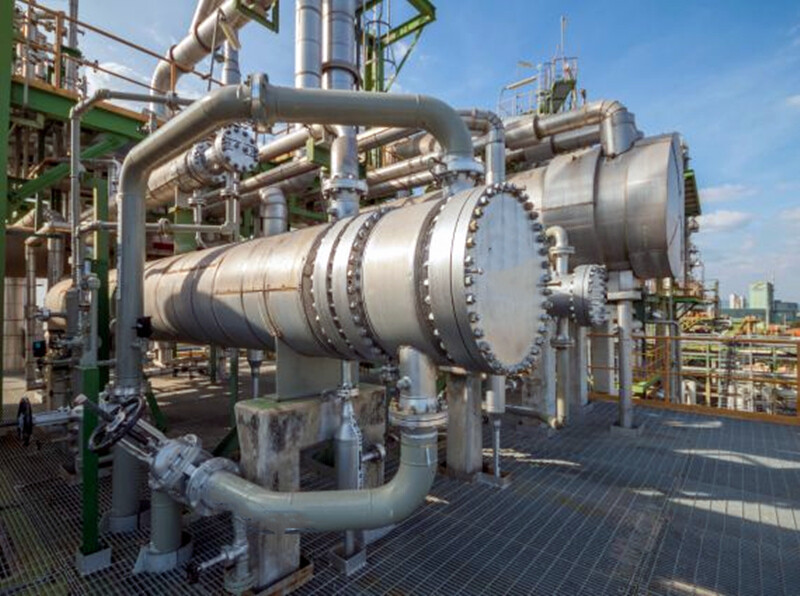Graphite Heat Exchanger is a specialized thermal transfer device designed to transfer heat between two or more fluids (liquids, gases, or vapors) in industrial processes. Its core distinguishing feature is the use of impermeable graphite as the primary heat transfer material—chosen for its exceptional chemical stability, high thermal conductivity, and resistance to aggressive corrosive media. Unlike conventional metal heat exchangers (e.g., carbon steel, stainless steel), it excels in harsh environments where strong acids, oxidizing agents, or toxic solvents would rapidly corrode or contaminate other materials.
Core Material: Impermeable Graphite
The performance of a graphite heat exchanger depends entirely on its key material—impermeable graphite (not ordinary industrial graphite). Raw graphite is porous and prone to leakage, so it undergoes a critical modification process to become suitable for heat transfer:
Impregnation Treatment: High-purity graphite blanks (fixed carbon content ≥99%, bulk density ≥1.7 g/cm³) are impregnated with resin (e.g., phenolic resin, furan resin) or metals (e.g., antimony, lead) under high pressure (≥0.8 MPa). This fills the graphite’s pores, eliminating leakage and enhancing mechanical strength.
Key Properties:
Chemical Inertness: Resists almost all strong acids (sulfuric acid, hydrochloric acid, nitric acid), oxidizing agents, and organic solvents (except high-temperature chlorine gas or molten salts).
High Thermal Conductivity: 110–150 W/(m·K), 3x that of carbon steel and 100x that of glass—ensuring efficient heat transfer.
Low Thermal Expansion: 1/5 that of carbon steel, avoiding deformation or cracking under rapid temperature fluctuations (-20°C to 200°C, or higher with modified grades).
How It Works (Basic Heat Transfer Mechanism)
The operating principle aligns with general heat exchanger logic but leverages graphite’s unique properties:
Fluid Circulation: Two fluids (hot and cold) flow in separate, sealed channels (tubes/holes) without mixing. For example, in sulfuric acid dilution:
Hot Fluid: Concentrated sulfuric acid (98%) mixed with water, which releases massive heat (dilution heat) and reaches 150°C+.
Cold Fluid: Cooling water or a refrigerant flowing in the shell side (around the graphite tubes).
Heat Transfer: Heat from the hot fluid passes through the thin, high-conductivity graphite walls to the cold fluid.
Temperature Control: The cold fluid absorbs heat and exits at a higher temperature, while the hot fluid (e.g., diluted sulfuric acid) is cooled to ≤50°C (meeting process requirements) before exiting.

Key Advantages
Graphite heat exchangers solve critical pain points in industrial thermal transfer, making them irreplaceable in specific scenarios:
Superior Corrosion Resistance: The only cost-effective option for processes involving 98% sulfuric acid, 37% hydrochloric acid, or concentrated nitric acid—where stainless steel (304/316L) corrodes in weeks and titanium/hastelloy alloys are prohibitively expensive.
Efficient Heat Transfer: Outperforms all non-metallic alternatives (glass, plastic, ceramic) and matches/surpasses many metals, enabling rapid heat transfer even with small temperature differences.
Purity Assurance: No metal ions leach into fluids (unlike metal exchangers), making it ideal for pharmaceutical, food, or electronic industries where product contamination is unacceptable (e.g., food-grade citric acid refining).
Long Service Life: 8–12 years of stable operation (vs. 1–2 years for metal exchangers in corrosive environments), reducing replacement costs and downtime.
Industrial Applications
It is a "must-have" in industries with harsh, corrosive thermal processes:
Chemical Industry: Sulfuric acid dilution/concentration, hydrochloric acid desorption, nitric acid condensation, organic acid (acetic acid, formic acid) heating/cooling.
Metallurgy Industry: Acid pickling (removing rust/oxide scales from steel/non-ferrous metals) – heating/cooling pickling solutions (e.g., HCl + Fe²⁺ mixtures).
Environmental Protection: Treatment of high-salt, high-acid wastewater (e.g., electroplating, chemical wastewater) – heating for evaporation or cooling before neutralization.
Pharmaceutical/Food Industry: Cooling of drug intermediates (acidic reactions), concentration of food-grade organic acids (no contamination risk).


